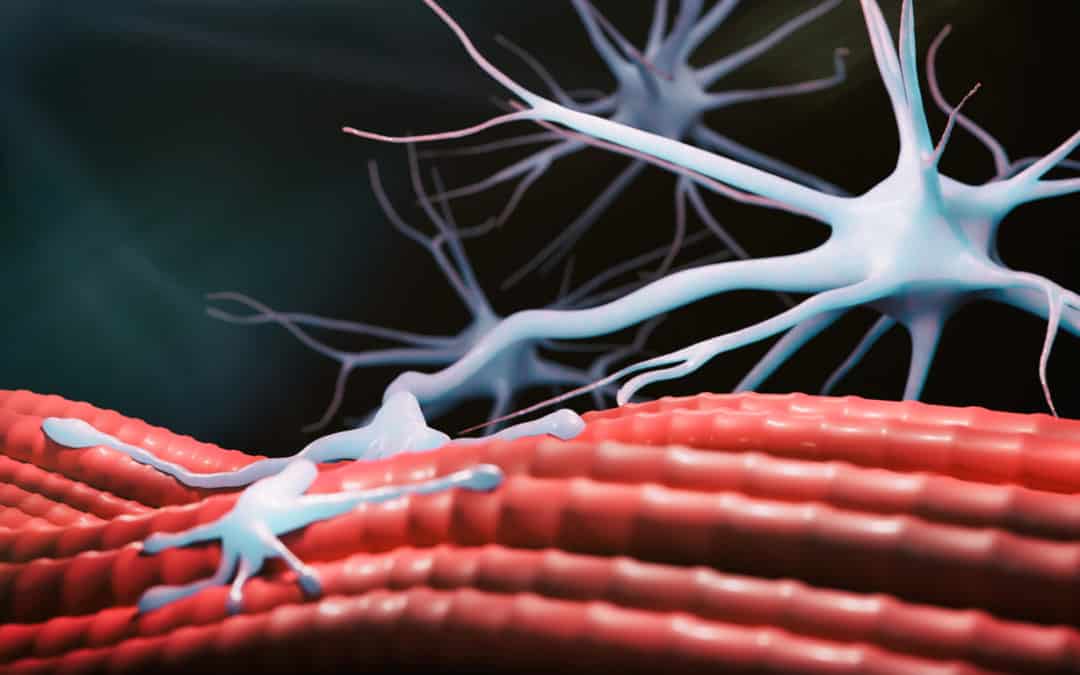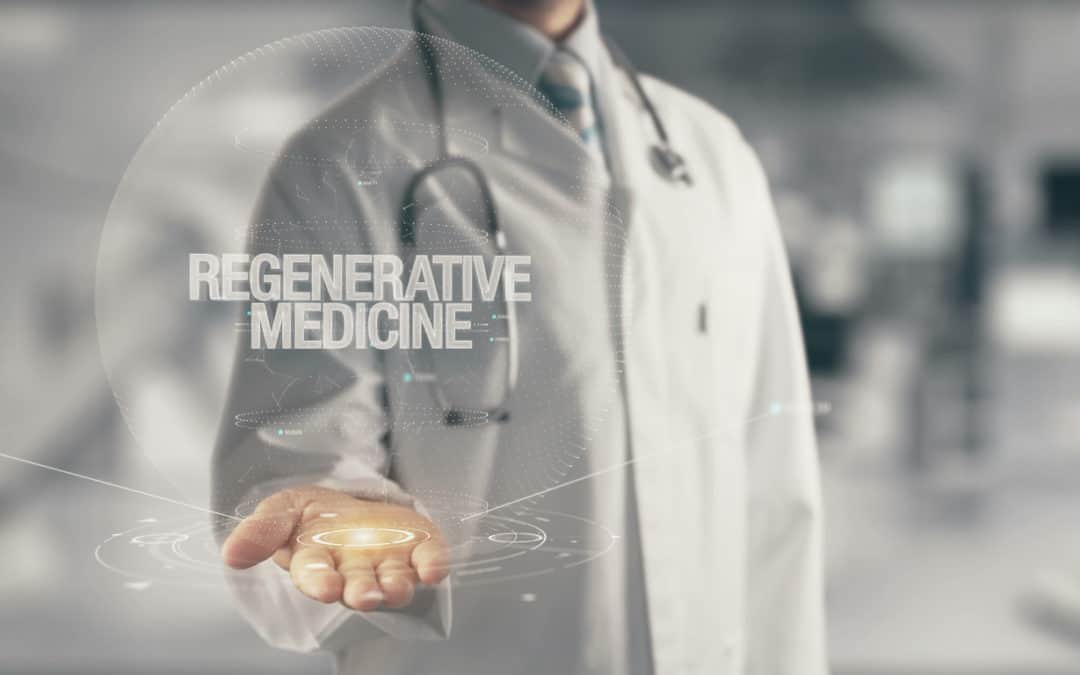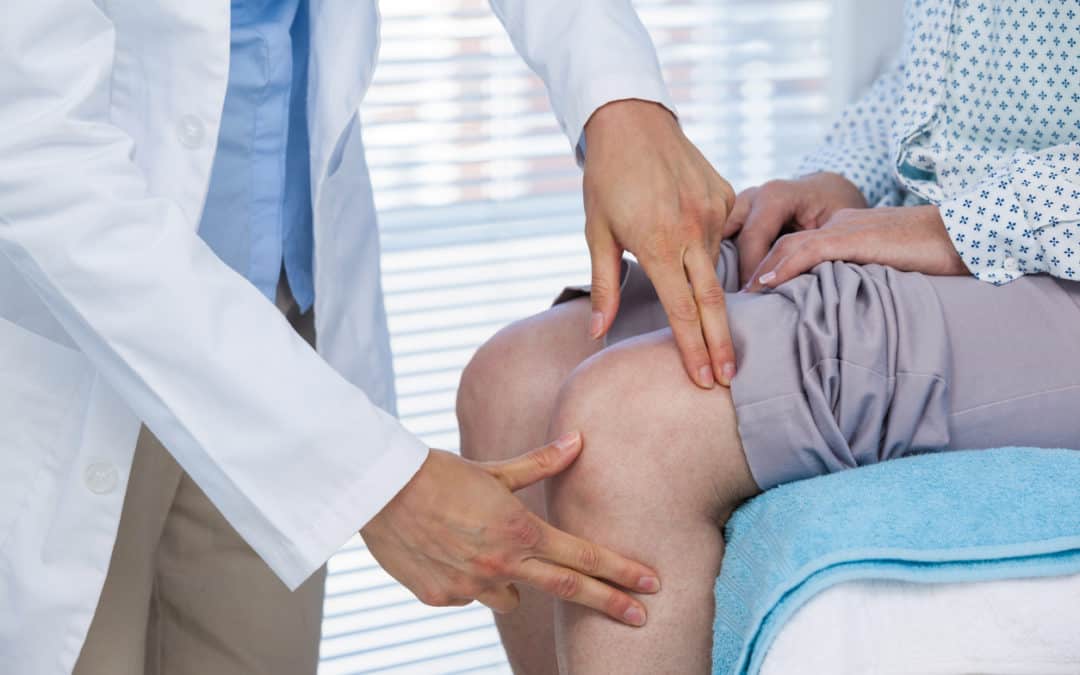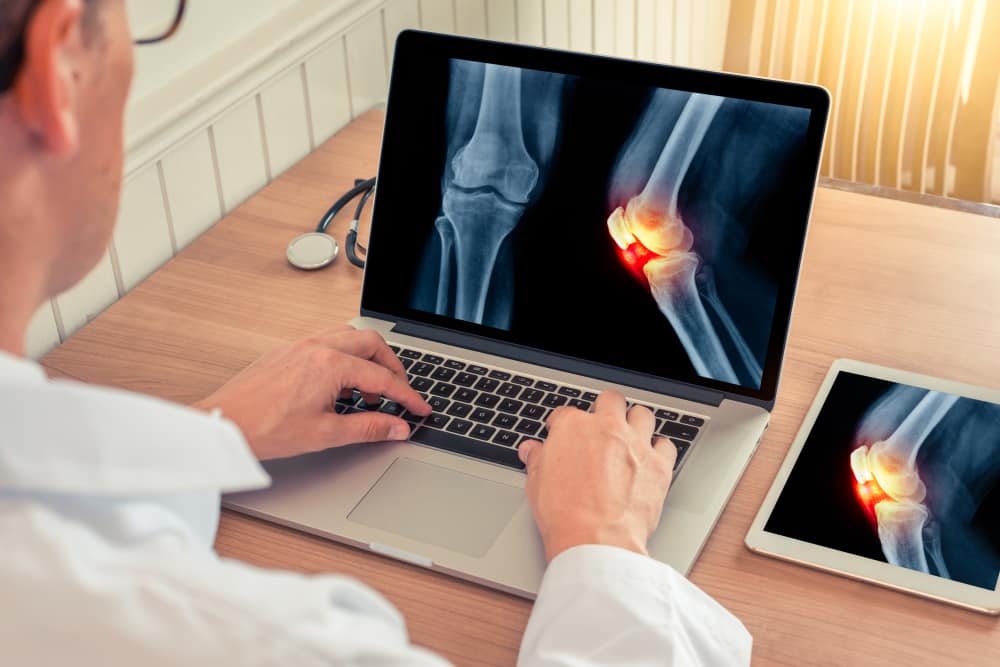
Mar 30, 2021
Dr. Christopher J. Rogers, co-founder of DataBiologics, LLC., is proud to announce a milestone in the collection of Regenerative Medicine data. DataBiologics, a patient-reported outcomes registry has collected more than 10,000 results from patients who received cell-based treatment. These included platelet-rich plasma (PRP), bone marrow concentration, and adipose-derived regenerative cells for the treatment of arthritis, tendon tears, and many other orthopedic conditions. To learn more about the DataBiologics registry and the results of these innovative treatments, click below to continue:
Orthopedics This Week- 03-23-21_DataBiologics

Mar 5, 2021
Muscle strain and muscle tears are not limited to sports injuries, they can also occur on the job or at home. One wrong move, a fall, or any injury can lead to significant muscle damage in the back, legs, or arms.
A strain or pulled muscle occurs when the fibers in the muscles are overstretched. When those fibers become stretched so thin that they break, it becomes a muscle tear.
Depending on the severity of the injury, it may take anywhere from a few days to several weeks to fully heal from these injuries. Muscle regeneration usually starts during the first four to five days after injury, peaks at two weeks, and then gradually diminishes three to four weeks after the injury. In severe cases, it may take surgery to repair a muscle tear.
Can cellular treatments help patients heal more quickly and naturally from these injuries?
How Do Cellular Treatments Promote Healing Muscle Tissue?
Cellular treatments for musculoskeletal injuries operate on the principle that the body has the ability to heal itself. Regenerative medicine specialists use certain cells in our body that are involved in healing to stimulate the repair of damaged tissues and augment the body’s healing response.
These innovative cell therapies have been successfully used to treat orthopedic conditions.
- Platelet Rich Plasma: Platelets in blood release growth factors and proteins that promote tissue repair, while the plasma carries the hormones, electrolytes, and nutrients required to nourish cells during the healing process. Platelet-rich plasma treatments can be customized to create specific formulations for each type of tissue being treated (muscle, tendon, ligament, cartilage).
- Stem Cell Treatments: Cells derived from the patient’s own bone marrow or adipose (fat) tissue produce molecules that stimulate the production of new blood vessels, awaken other stem cells and encourage newly forming cells to produce collagen and other proteins essential for creating new healthy new tissue.
The use of cell therapies for muscle injuries have been studied in many clinical trials. There is evidence that it can induce muscle cell proliferation, assist with tissue healing and shorten the time for athletes to return to sports after an injury. Nevertheless, more studies are needed to evaluate the use of PRP for muscle injuries. There are many exciting new potential therapeutic applications of cellular therapies like stem cell treatments in repairing muscle injuries without the need for surgery. Advances in tissue engineering and biotechnology will pave the way for this to become a reality in the near future.
Drs. Christopher Rogers and Mary A. Ambach of San Diego Orthobiologics Medical Group are nationally recognized experts in the field of regenerative medicine. For more than 20 years, they have been helping patients with joint and spine injuries overcome their pain through the latest advances in cell-based treatments.

Feb 19, 2021
Regenerative medicine is a field in medicine that develops methods to regrow, repair, or replace damaged diseased cells, tissues or organs. It utilizes the body’s natural healing processes to rebuild damaged tissues and heal injuries. In the field of orthopedics, regenerative medicine holds great promise for helping patients with injuries or degeneration involving the musculoskeletal system.
Damage to the joints, ligaments, tendons, or discs can lead to chronic pain in various parts of the body including:
- Lower Back
- Knees
- Hips
- Neck
- Feet and ankles
- Hands and wrists
- Elbows and Shoulders
Regenerative medicine addresses the reason for the pain by helping to heal and create new healthy tissues.
How Does it Work?
Regenerative treatments for orthopedic conditions use the patient’s own blood and tissues from bone marrow or fat to kick-start the body’s own healing processes. These cells are removed from the patient and concentrated to isolate the healing proteins, molecules, and nutrients they contain. These super-healers are then re-injected into the site of damaged tissue to encourage new cell growth and healing.
The U.S. Food & Drug Administration (FDA) does not allow the use of embryonic cells or birth tissue products for treating orthopedic conditions. However regenerative medicine physicians can use FDA-compliant autologous cellular products to treat musculoskeletal problems.
These autologous cell therapies include:
- Platelet Rich Plasma: Platelets in the patient’s own blood release growth factors and proteins that promote tissue repair, while the plasma carries the hormones, electrolytes and nutrients required to nourish cells during the healing process.
- Cell Based Therapies: Adult Stem Cells taken from the patient’s own fat tissue (adipose) or bone marrow have the unique ability to develop into the specific kind of cell needed and possess molecules that direct other cells in the injured area to form new blood vessels, awaken other stem cells and encourage newly forming cells to produce collagen and other proteins essential for creating new healthy tissues.
Prolotherapy (Proliferative Therapy) is a Regenerative injection using natural medications, specifically dextrose, that help the body jump-start its own natural healing response when injected into the injured area.
Is Regenerative Medicine Painful?
For many years, patients with unresolved chronic orthopedic pain were left to consider surgery as their last option and best hope for long-term pain relief. But with advancements in regenerative medicine, these patients can avoid major surgery and lengthy rehabilitation.
Regenerative treatments are injection procedures and unlike surgery, they do not involve the pain or risk of large surgical incisions. Blood, bone marrow, or fat tissue is collected, processed, and injected into injured tissue on the same day. These procedures are typically performed on an out-patient basis and recovery begins at home within hours of the treatment.
Ask the Right Questions, Get the Best Results
When considering regenerative medicine treatments, it is important that you do your research in selecting a physician that is highly skilled and experienced in regenerative medicine. The following are questions that you need to ask before making your decision. Patients get the best outcomes when the answer is “yes” to all these questions.
- Is the physician board-certified and specializes in diagnosing and treating orthopedic conditions? Examples include Physical Medicine and Rehabilitation, Sports Medicine, Orthopedics, Pain Management physicians.
- Do you use appropriate, advanced, FDA-compliant devices in the preparation of the cellular products that can deliver the best results?
- Are the treatments performed using imaging guidance to ensure precise delivery of the regenerative products to the site of the injury?
- Is the practice compliant with FDA regulations?
- Do you track your outcomes and present them at medical conferences or publish them in medical journals?
Drs. Christopher J. Rogers and Mary A. Ambach of San Diego Orthobiologics Medical Group together have successfully treated thousands of patients with PRP and cell-based treatments for more than three decades. They are published authors and stem cell researchers. Their facility in Carlsbad contains the most advanced Regenerative Medicine technology in San Diego and offers same-day treatments with the highest level of safety and efficacy

Feb 11, 2021
It may seem counterintuitive, but sometimes regenerative medicine specialists may purposely irritate the tissues in the joint to achieve the ultimate goal of relieving joint pain.
Using irritation to obtain pain relief sounds counterproductive. But in regenerative medicine, when an irritant solution like dextrose (sugar water) is injected into the joint, it actually triggers new tissue growth ultimately leading to long-term reductions in inflammation and pain.
The procedure is known as prolotherapy. It is a non-surgical treatment that can naturally strengthen the joint and lessen pain.
Is Prolotherapy New?
Prolotherapy is one of the first regenerative treatments to gain popularity. Modern-day prolotherapy was developed in 1937 by Dr. Earl Gedney, an osteopathic physician, and surgeon who used it to treat his own thumb injury. It is now practiced by physicians around the world to treat a number of conditions, including ligament laxity and osteoarthritis. It can provide pain relief to patients suffering from pain in the knees, shoulders, hips, ligament and tendon injuries, and SI joint.
This non-surgical treatment delivers a targeted sugar solution to the injured area which acts as an irritant and spurs the body’s own natural healing processes to strengthen and repair damaged tissues. As the supporting tissues get stronger, the joint becomes more stable, inflammation is reduced and the pain abates.
What to Expect from Prolotherapy Treatments
Prolotherapy is performed on an out-patient basis. After a thorough medical history, physical examination, and imaging tests as appropriate, the regenerative medicine specialist will determine if your condition will benefit from prolotherapy. The injection is performed using fluoroscopy (digital x-ray) or ultrasound guidance for precise delivery of the solution to the target region.
The extent of the injury will dictate the course of treatment. Multiple targeted injections may be required in each session and a series of sessions every 1-2 weeks may be necessary.
For patients suffering from joint pain, prolotherapy is a safe, natural, and non-invasive way to provide pain relief and treat the underlying injury.
Drs. Christopher Rogers and Mary A. Ambach have successfully treated thousands of patients with prolotherapy and platelet-rich plasma therapy. San Diego Orthobiologics Medical Group’s state-of-the-art facilities offer patients on-site processing and preparation of their customized treatments.

Feb 5, 2021
The researchers and scientists of the International Human Genome Project first mapped our full genetic blueprint 18 years ago.[i] Their breakthrough efforts enable numerous advances in how we treat and prevent various diseases and orthopedic conditions.
The Human Genome roadmap allows us to better understand the genes that are associated with certain diseases and how these genes can predispose a person to develop these diseases. It can also help in understanding how genes can be altered to improve disease processes.
In the field of orthopedics, a group of scientists at Stanford University discovered a biological indicator of cartilage degeneration and inflammation in patients with arthritis, disc degeneration, and sciatica. This molecular complex is called the Fibronectin-Aggrecan Complex or FAC.
Alpha-2-Macroglobulin (A2M) is a Master Protease Inhibitor
Having identified the FAC molecular complex, the Stanford team recognized how this biomarker could be used in conjunction with a naturally-occurring blood protein called Alpha-2 Macroglobulin or A2M to improve the effectiveness of treatments for degenerative disc disease and joint arthritis. The FAC can be measured to predict which patients will have the best results with A2M therapy.
A2M inhibits the breakdown of collagen in cartilage and has been scientifically proven to stop the progression of joint cartilage and disc degeneration. It is known as a Master Protease Inhibitor. It inhibits proteases, which are enzymes that breaks down proteins in cartilage. Much like a levee along a rising river, it “holds back” and prevents damage to tissues.
How A2M therapy Works
A2M therapy is a non-invasive treatment performed on an outpatient basis. After conducting a complete examination, your physician will determine if you are a good candidate for this treatment. Further imaging studies such as x-ray, ultrasound, or MRI may be necessary to determine the cause of your pain.
The A2M procedure starts with a simple blood draw from the arm. The treatment is autologous, which means the A2M is derived from the patient’s own body. There are no donor products used. The blood is concentrated using an FDA-approved device in our lab. After numbing the treatment area, the concentrated A2M is injected on the same day. Digital x-ray or ultrasound guidance will be used to make the treatment comfortable, safe and precise.
Currently, this breakthrough treatment is only being offered by a select number of physicians across the country. By screening patients for these treatments, regenerative medicine specialists are able to offer targeted A2M treatment to appropriate patients. This gives patients new hope for relief of pain and inflammation due to common orthopedic conditions.
Drs. Christopher Rogers and Mary A. Ambach of San Diego Orthobiologics Medical Group are two of just a handful of physicians in San Diego who offer A2M therapy for their patients. They have found this and other new regenerative medicine therapies valuable for the treatment of pain and inflammation associated with arthritic joints and disc degeneration.
Sources:
[i] https://www.genome.gov/human-genome-project#:~:text=Beginning%20on%20October%201%2C%201990,is%20the%20Human%20Genome%20Project%3F
https://cytonics.com/
https://sdomg.com/master-protease-inhibitor-a2m/

Jan 29, 2021
Regenerative medicine uses the natural healing capabilities of stem cells to help repair injured tissues. One of the biggest challenges facing practitioners of this exciting new medical subspecialty is helping patients understand that not all stem cells are the same.
The ABC’s of Stem Cells
Stem cells are unique because they have the ability to renew themselves and become different kinds of cells that are needed by the body. In fact, they are the only cells in the body that are capable of generating new cell types.[i] To better understand what kind of stem cells are used for orthopedic conditions, it is helpful to know that there are several different types.
Embryonic stem cells are derived from an embryo that develops from fertilized human eggs in the laboratory. They are used for research purposes only. There are no FDA approved treatments that use embryonic stem cells.
Stem cells derived from birth tissue products such as umbilical cord blood are approved for use in blood cancers and other blood disorders like sickle cell disease. However, the stem cells from umbilical cord blood and amniotic fluid are not approved by the US Food and Drug Administration (FDA) for any orthopedic indication. The safety and efficacy of these products have not been tested in orthopedic conditions and the FDA does not permit their use.
Mesenchymal stem cells (MSCs) are a specific type of adult stem cell that have the ability to differentiate into bone, cartilage and muscle cells.[ii] These stem cells are found in all tissues of our body in limited quantities, but they tend to exist in higher amounts in the bone marrow and adipose tissue (fat). For orthopedic applications, your physician may obtain these cells from your own (autologous) bone marrow or adipose tissue (fat). These tissues not only contain mesenchymal stem cells, they also contain other cells that are anti-inflammatory and regenerative. Once these cells are injected, they release hundreds of molecules that decrease inflammation, fight infection and repair injured tissues.
The Body: A Constant Work in Progress
There are more than 37 trillion cells in our body which are constantly dying and being replaced. There are more than 200 types of cells in our body and they each have different lifespans. Platelets live for a week, red blood cells live for about four months, bone and muscle cells live about 25 years, while brain cells can live a lifetime.
An injury or disease can hasten the death of cells. But often, the wear-and-tear of the natural aging process cause tissues to become damaged. Stem cell treatments enable regenerative medicine specialists to boost the body’s own natural healing abilities by bringing concentrated doses of these powerful building blocks directly to the site of injured or degenerated joint, cartilage or tissue.
Although regenerative medicine is a relatively new specialty within the field of orthopedics, cell-based treatments have been shown to be an effective non-surgical option for patients who have failed standard treatments or want to avoid surgery.
By combining the body’s own powerful healing capabilities with the latest in scientific and medical technology, orthopedic stem cell therapies provide lasting pain relief and help patients live their life fully.
Drs. Christopher Rogers and Mary A. Ambach have been providing cellular treatments for orthopedic conditions for more than three decades. Their clinical outcome data reveals that the majority of their patients are satisfied and successfully respond to these orthobiologic therapies which also demonstrate excellent safety.
[i] https://www.mayoclinic.org/tests-procedures/bone-marrow-transplant/in-depth/stem-cells/art-20048117
[ii] https://www.mayo.edu/research/labs/bone-injury-repair/research/mesenchymal-stem-cell-biology





